Tanager
| Tanagers | |
|---|---|

| |
| Scientific classification | |
| Domain: | Eukaryota |
| Kingdom: | Animalia |
| Phylum: | Chordata |
| Class: | Aves |
| Order: | Passeriformes |
| Superfamily: | Emberizoidea |
| Family: | Thraupidae Cabanis, 1847 |
| Type genus | |
| Thraupis Boie, F., 1826
| |
| Genera | |
|
Many: see text | |
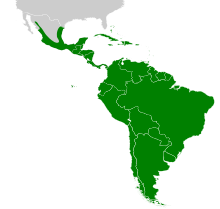
| |
The tanagers (singular /ˈtænədʒər/) comprise the bird family Thraupidae, in the order Passeriformes. The family has a Neotropical distribution and is the second-largest family of birds. It represents about 4% of all avian species and 12% of the Neotropical birds.[1]
Traditionally, the family contained around 240 species of mostly brightly colored fruit-eating birds.[2] As more of these birds were studied using modern molecular techniques, it became apparent that the traditional families were not monophyletic. Euphonia and Chlorophonia, which were once considered part of the tanager family, are now treated as members of the Fringillidae, in their own subfamily (Euphoniinae). Likewise, the genera Piranga (which includes the scarlet tanager, summer tanager, and western tanager), Chlorothraupis, and Habia appear to be members of the family Cardinalidae,[3] and have been reassigned to that family by the American Ornithological Society.[4]
Description
[edit]Tanagers are small to medium-sized birds. The shortest-bodied species, the white-eared conebill, is 9 cm (4 in) long and weighs 6 g (0.2 oz), barely smaller than the short-billed honeycreeper. The longest, the magpie tanager is 28 cm (11 in) and weighs 76 g (2.7 oz). The heaviest is the white-capped tanager, which weighs 114 g (4.02 oz) and measures about 24 cm (9.4 in). Both sexes are usually the same size and weight.
Tanagers are often brightly colored, but some species are black and white. Males are typically more brightly colored than females and juveniles. Most tanagers have short, rounded wings. The shape of the bill seems to be linked to the species' foraging habits.
Distribution
[edit]Tanagers are restricted to the Western Hemisphere and mainly to the tropics. About 60% of tanagers live in South America, and 30% of these species live in the Andes. Most species are endemic to a relatively small area.
Behavior
[edit]Most tanagers live in pairs or in small groups of three to five individuals. These groups may consist simply of parents and their offspring. These birds may also be seen in single-species or mixed flocks. Many tanagers are thought to have dull songs, though some are elaborate.[citation needed]
Diet
[edit]Tanagers are omnivorous, and their diets vary by genus. They have been seen eating fruits, seeds, nectar, flower parts, and insects. Many pick insects off branches or from holes in the wood. Other species look for insects on the undersides of leaves. Yet others wait on branches until they see a flying insect and catch it in the air. Many of these particular species inhabit the same areas, but these specializations alleviate competition.
Breeding
[edit]The breeding season is March through June in temperate areas and in September through October in South America. Some species are territorial, while others build their nests closer together. Little information is available on tanager breeding behavior. Males show off their brightest feathers to potential mates and rival males. Some species' courtship rituals involve bowing and tail lifting.
Most tanagers build cup nests on branches in trees. Some nests are almost globular. Entrances are usually built on the side of the nest. The nests can be shallow or deep. The species of the tree in which they choose to build their nests and the nests' positions vary among genera. Most species nest in an area hidden by very dense vegetation. No information is yet known regarding the nests of some species.
The clutch size is three to five eggs. The female incubates the eggs and builds the nest, but the male may feed the female while she incubates. Both sexes feed the young. Five species have helpers assist in feeding the young. These helpers are thought to be the previous year's nestlings.
Taxonomy
[edit]The family Thraupidae was introduced (as the subfamily Thraupinae) in 1847 by German ornithologist Jean Cabanis. The type genus is Thraupis.[5][6]
The family Thraupidae is a member of an assemblage of over 800 birds known as the New World, nine-primaried oscines. The traditional pre-molecular classification was largely based on the different feeding specializations. Nectar-feeders were placed in Coerebidae (honeycreepers), large-billed seed-eaters in Cardinalidae (cardinals and grosbeaks), smaller-billed seed-eaters in Emberizidae (New World finches and sparrows), ground-foraging insect-eaters in Icteridae (blackbirds) and fruit-eaters in Thraupidae.[1] This classification was known to be problematic as analyses using other morphological characteristics often produced conflicting phylogenies.[7] Beginning in the last decade of the 20th century, a series of molecular phylogenetic studies led to a complete reorganization of the tradition families. Thraupidae now includes large-billed seed eaters, thin-billed nectar feeders, foliage gleaners as well as fruit-eaters.[1]
One consequence of redefining the family boundaries is that for many species their common names are no longer congruent with the families in which they are placed. As of July 2020 there are 39 species with "tanager" in the common name that are not placed in Thraupidae. These include the widely distributed scarlet tanager and western tanager which are both now placed in Cardinalidae. There are also 106 species within Thraupidae that have "finch" in their common name.[8]
A molecular phylogenetic study published in 2014 revealed that many of the traditional genera were not monophyletic.[1] In the resulting reorganization six new genera were introduced, eleven genera were resurrected and seven genera were abandoned.[9][8]
As of July 2023 the family contains 386 species which are divided into 15 subfamilies and 105 genera.[1][8] For a complete list, see the article List of tanager species.
List of genera
[edit]Catamblyrhynchinae
[edit]The plushcap has no close relatives and is now placed in its own subfamily. It was previously placed either in the subfamily Catamblyrhynchinae within the Emberizidae or in its own family Catamblyrhynchidae.[1]
| Image | Genus | Species |
|---|---|---|
 |
Catamblyrhynchus Lafresnaye, 1842 |
|
Charitospizinae
[edit]The coal-crested finch is endemic to the grasslands of Brazil and has no close relatives. It is unusual in that both sexes have a crest. It was formerly placed in Emberizidae.
| Image | Genus | Species |
|---|---|---|
 |
Charitospiza Oberholser, 1905 |
|
Orchesticinae
[edit]Two species with large thick bills. Parkerthraustes was formerly placed in Cardinalidae.
| Image | Genus | Species |
|---|---|---|
 |
Orchesticus Cabanis, 1851 |
|
 |
Parkerthraustes Remsen, 1997 |
|
Nemosiinae
[edit]Brightly colored sexually dichromatic birds, most form single-species flocks
| Image | Genus | Species |
|---|---|---|
 |
Nemosia Vieillot, 1816 |
|
 |
Cyanicterus Bonaparte, 1850 |
|
 |
Sericossypha Lesson, 1844 |
|

|
Compsothraupis Richmond, 1915 |
|
Emberizoidinae
[edit]Grassland dwelling birds that were formerly placed in Emberizidae.
| Image | Genus | Species |
|---|---|---|
 |
Coryphaspiza G.R. Gray, 1840 |
|
 |
Embernagra Lesson, 1831 |
|
 |
Emberizoides Temminck, 1822 |
|
Porphyrospizinae
[edit]Yellow billed birds: The blue finch (Rhopospina caerulescens) was formerly placed in the Cardinalidae; the other species were formerly placed in Emberizidae.
| Image | Genus | Species |
|---|---|---|
 |
Incaspiza Ridgway, 1898 |
|
 |
Rhopospina Cabanis, 1851 |
|
Hemithraupinae
[edit]These species are sexually dichromatic and many have yellow and black plumage. Except for Heterospingus they have slender bills.
| Image | Genus | Species |
|---|---|---|
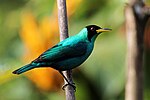 |
Chlorophanes Reichenbach, 1853 |
|
 |
Iridophanes Ridgway, 1901 |
|
 |
Chrysothlypis Berlepsch, 1912 |
|
 |
Heterospingus Ridgway, 1898 |
|
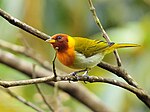 |
Hemithraupis Cabanis, 1850 |
|
Dacninae
[edit]Sexually dichromatic species—males have blue plumage and females are green.
| Image | Genus | Species |
|---|---|---|
 |
Tersina Vieillot, 1819 |
|
 |
Cyanerpes Oberholser, 1899 |
|
 |
Dacnis Cuvier, 1816 |
|
Saltatorinae
[edit]Mainly arboreal with long tails and thick bills. Formerly placed in Cardinalidae.
| Image | Genus | Species |
|---|---|---|
 |
Saltatricula Burmeister, 1861 |
|
 |
Saltator Vieillot, 1816 |
|
Coerebinae
[edit]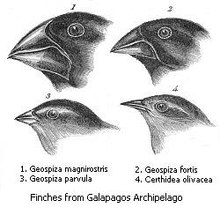
This subfamily includes Darwin's finches that are endemic to the Galápagos Islands and Cocos Island. Most of these species were formerly placed in the Emberizidae; the exceptions are the bananaquit that was placed in the Parulidae and the orangequit that was placed in the Thraupidae. These species build domed or covered nests with side entrances. They have evolved a variety of foraging techniques, including nectar-feeding (Coereba, Euneornis), seed-eating (Geospiza, Loxigilla, Tiaris), and insect gleaning (Certhidea).[1]
| Image | Genus | Species |
|---|---|---|
 |
Coereba Vieillot, 1809 |
|
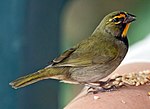 |
Tiaris Swainson, 1827 |
|
 |
Euneornis Fitzinger, 1856 |
|
 |
Melopyrrha Bonaparte, 1853 |
|
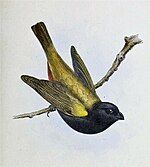 |
Loxipasser Bryant, 1866 |
|
 |
Phonipara Bonaparte, 1850 |
|
 |
Loxigilla Lesson, 1831 |
|
 |
Melanospiza Ridgway, 1897 |
|
 |
Asemospiza Burns, Unitt, & Mason, 2016 |
|
| Image | Genus | Species |
|---|---|---|
 |
Certhidea Gould, 1837 |
|
 |
Platyspiza Ridgway, 1897 |
|
 |
Pinaroloxias Sharpe, 1885 |
|
 |
Camarhynchus Gould, 1837 |
|
 |
Geospiza Gould, 1837 |
|
Tachyphoninae
[edit]Most of these are lowland species. Many have ornamental features such as crests, and many have sexually dichromatic plumage.[1]
| Image | Genus | Species |
|---|---|---|
 |
Volatinia Reichenbach, 1850 |
|
 |
Conothraupis Sclater, PL, 1880 |
|
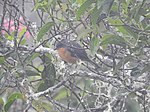 |
Creurgops Sclater, PL, 1858 |
|
 |
Eucometis Sclater, PL, 1856 |
|
 |
Trichothraupis Cabanis, 1851 |
|
 |
Heliothraupis Lane et al., 2021 |
|
 |
Loriotus Jarocki, 1821 |
|
 |
Coryphospingus Cabanis, 1851 |
|
 |
Tachyphonus Vieillot, 1816 |
|
 |
Rhodospingus Sharpe, 1888 |
|
 |
Lanio Vieillot, 1816 |
|
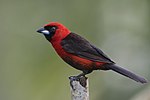 |
Ramphocelus Desmarest, 1805 |
|
Sporophilinae
[edit]These species were formerly placed in Emberizidae.
| Image | Genus | Species |
|---|---|---|
 |
Sporophila Cabanis, 1844 |
Seedeaters and seed finches (includes species previously assigned to Dolospingus and Oryzoborus) 41 species:
|
Poospizinae
[edit]Some of these species were formerly placed in Emberizidae.
| Image | Genus | Species |
|---|---|---|
 |
Piezorina Lafresnaye, 1843 |
|
 |
Xenospingus Cabanis, 1867 |
|
 |
Cnemoscopus Bangs & Penard, 1919 |
|
 |
Pseudospingus Berlepsch & Stolzmann, 1896 |
|
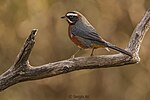 |
Poospiza Cabanis, 1847 |
|
 |
Kleinothraupis Burns, Unitt, & Mason, 2016 |
|
 |
Sphenopsis Sclater, 1862 |
|
 |
Thlypopsis Cabanis, 1851 |
|
 |
Castanozoster Burns, Unitt, & Mason, 2016 |
|
 |
Donacospiza Cabanis, 1851 |
|
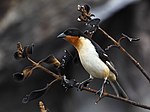 |
Cypsnagra Lesson, R, 1831 |
|
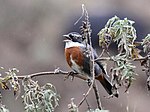 |
Poospizopsis Berlepsch, 1893 |
|
 |
Urothraupis Taczanowski & Berlepsch, 1885 |
|
 |
Nephelornis Lowery & Tallman, 1976 |
|
 |
Microspingus Taczanowski, 1874 |
|
Diglossinae
[edit]This is a morphologically diverse group that includes seed-eaters (Nesospiza, Sicalis, Catamenia, Haplospiza), arthropod feeders (Conirostrum), a bamboo specialist (Acanthidops), an aphid feeder (Xenodacnis), and boulder field specialists (Idiopsar). Many species live at high altitudes. Conirostrum was previously placed in Parulidae, Diglossa was placed in Thraupidae and the remaining genera were placed in Emberizidae.[1]
| Image | Genus | Species |
|---|---|---|
 |
Conirostrum d'Orbigny & Lafresnaye, 1838 |
|
 |
Sicalis F. Boie, 1828 |
13 species
|
 |
Phrygilus Cabanis, 1844 |
|
 |
Nesospiza Cabanis, 1873 |
|
 |
Rowettia Lowe, 1923 |
|
 |
Melanodera Bonaparte, 1850 |
|
 |
Geospizopsis Bonaparte, 1856 |
|
 |
Haplospiza Cabanis, 1851 |
|
 |
Acanthidops Ridgway, 1882 |
|
 |
Xenodacnis Cabanis, 1873 |
|
 |
Idiopsar Cassin, 1867 |
|
 |
Catamenia Bonaparte, 1850 |
|
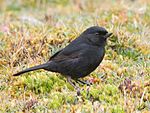 |
Diglossa Wagler, 1832 |
18 species
|
Thraupinae
[edit]Typical tanagers
| Image | Genus | Species |
|---|---|---|
 |
Calochaetes Sclater, PL, 1879 |
|
 |
Iridosornis Lesson, 1844 |
|
 |
Rauenia Wolters, 1980 |
|
 |
Pipraeidea Swainson, 1827 |
|
 |
Pseudosaltator K.J. Burns, Unitt & N.A. Mason, 2016 |
|
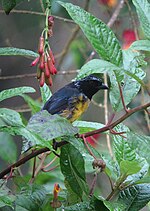 |
Dubusia Bonaparte, 1850 |
|
 |
Buthraupis Cabanis, 1851 |
|
 |
Sporathraupis Ridgway, 1898 |
|
 |
Tephrophilus R. T. Moore, 1934 |
|
 |
Chlorornis Reichenbach, 1850 |
|
 |
Cnemathraupis Penard, 1919 |
|
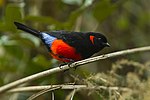 |
Anisognathus Reichenbach, 1850 |
|
 |
Chlorochrysa Bonaparte, 1851 |
|
 |
Wetmorethraupis Lowery & O'Neill, 1964 |
|
 |
Bangsia Penard, 1919 |
|
 |
Lophospingus Cabanis, 1878 |
|
 |
Neothraupis Hellmayr, 1936 |
|
 |
Diuca Reichenbach, 1850 |
|
 |
Gubernatrix Lesson, 1837 |
|
 |
Stephanophorus Strickland, 1841 |
|
 |
Cissopis Vieillot, 1816 |
|
 |
Schistochlamys Reichenbach, 1850 |
|
 |
Paroaria Bonaparte, 1832 |
|
 |
Ixothraupis Bonaparte, 1851 |
|
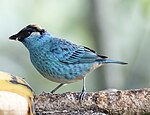 |
Chalcothraupis Bonaparte, 1851 |
|
 |
Poecilostreptus Burns, KJ, Unitt, & Mason, NA, 2016 |
|
 |
Thraupis F. Boie, 1826 |
|
 |
Stilpnia Burns, KJ, Unitt, & Mason, NA, 2016 |
14 species
|
 |
Tangara Brisson, 1760 |
28 species
|
Genera formerly placed in Thraupidae
[edit]Passerellidae – New World sparrows[10]
- Chlorospingus – eight species - bush-tanagers
- Oreothraupis – tanager finch
Cardinalidae – cardinals[11][7]
- Piranga – 9 species - northern tanagers
- Habia – five species - ant-tanagers or habias
- Chlorothraupis – three species
- Amaurospiza – four species
Fringillidae – subfamily Euphoniinae
- Euphonia – 27 species
- Chlorophonia – five species
Phaenicophilidae – Hispaniolan tanagers[10][12]
- Microligea – green-tailed warbler
- Xenoligea – white-winged warbler
- Phaenicophilus – two species
Mitrospingidae – Mitrospingid tanagers[10]
- Mitrospingus – two species
- Orthogonys – olive-green tanager
- Lamprospiza – red-billed pied tanager
- Nesospingus – Puerto Rican tanager[10][12]
- Calyptophilus – two species - chat-tanagers[10][12]
- Rhodinocichla – rosy thrush-tanager[10][12]
References
[edit]- ^ a b c d e f g h i Burns, K.J.; Shultz, A.J.; Title, P.O.; Mason, N.A.; Barker, F.K.; Klicka, J.; Lanyon, S.M.; Lovette, I.J. (2014). "Phylogenetics and diversification of tanagers (Passeriformes: Thraupidae), the largest radiation of Neotropical songbirds". Molecular Phylogenetics and Evolution. 75: 41–77. doi:10.1016/j.ympev.2014.02.006. PMID 24583021.
- ^ Storer, Robert W. (1970). "Subfamily Thraupinae". In Paynter, Raymond A. Jr (ed.). Check-List of Birds of the World. Vol. 13. Cambridge, Massachusetts: Museum of Comparative Zoology. pp. 246–408.
- ^ Yuri, T.; Mindell, D. P. (May 2002). "Molecular phylogenetic analysis of Fringillidae, "New World nine-primaried oscines" (Aves: Passeriformes)". Molecular Phylogenetics and Evolution. 23 (2): 229–243. doi:10.1016/S1055-7903(02)00012-X. PMID 12069553.
- ^ "Family: Cardinalidae". American Ornithological Society. Retrieved Feb 1, 2019.
- ^ Cabanis, Jean (1847). "Ornithologische Notizen". Archiv für Naturgeschichte (in German). 13: 186–256, 308–352 [316].
- ^ Melville, R.V. (1977). "Opinion 1069 Correction of entry in official list of family-group names in zoology for name number 428 (Thraupidae)". Bulletin of Zoological Nomenclature. 33 (3/4): 162–164.
- ^ a b Klicka, J.; Burns, K.; Spellman, G. M. (2007). "Defining a monophyletic Cardinalini: A molecular perspective". Molecular Phylogenetics and Evolution. 45 (3): 1014–1032. doi:10.1016/j.ympev.2007.07.006. PMID 17920298.
- ^ a b c Gill, Frank; Donsker, David; Rasmussen, Pamela, eds. (July 2021). "Tanagers and allies". IOC World Bird List Version 11.2. International Ornithologists' Union. Retrieved 18 December 2021.
- ^ Burns, K.J.; Unitt, P.; Mason, N.A. (2016). "A genus-level classification of the family Thraupidae (Class Aves: Order Passeriformes)". Zootaxa. 4088 (3): 329–354. doi:10.11646/zootaxa.4088.3.2. PMID 27394344.
- ^ a b c d e f g Barker, F.K.; Burns, K.J.; Klicka, J.; Lanyon, S.M.; Lovette, I.J. (2013). "Going to extremes: contrasting rates of diversification in a recent radiation of New World passerine birds". Systematic Biology. 62 (2): 298–320. doi:10.1093/sysbio/sys094. PMID 23229025.
- ^ Burns, K.J.; Hackett, S.J.; Klein, N.K. (2003). "Phylogenetic relationships of Neotropical honeycreepers and the evolution of feeding morphology". Journal of Avian Biology. 34 (4): 360–370. doi:10.1111/j.0908-8857.2003.03171.x.
- ^ a b c d e Barker, F.K.; Burns, K.J.; Klicka, J.; Lanyon, S.M.; Lovette, I.J. (2015). "New insights into New World biogeography: An integrated view from the phylogeny of blackbirds, cardinals, sparrows, tanagers, warblers, and allies". The Auk. 132 (2): 333–348. doi:10.1642/AUK-14-110.1.
Further reading
[edit]- Remsen, J. V. Jr. (2016). "Proposal 730: Revise generic limits in the Thraupidae". South American Classification Committee, American Ornithologists' Union. Retrieved 7 October 2019.
External links
[edit]- Jungle-walk.com tanager pictures
- Tanager videos, photos and sounds on the Internet Bird Collection
- Thraupidae at Curlie
- . . 1914.
